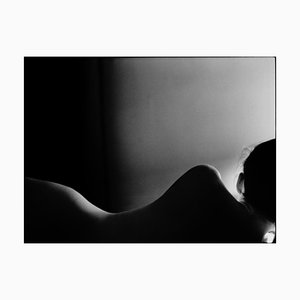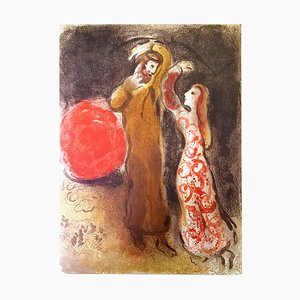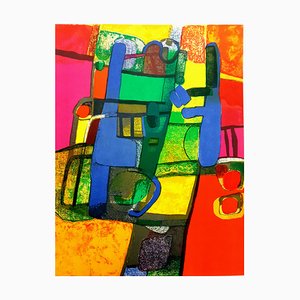Camille Hilaire (1916-2004) Green Trees Original Signed Watercolor 43 x 36 cm Framed Camille Hilaire (1916-2004) Camille Hilaire began painting from a young age. At fifteen, he discovered the work of Albrecht Dürer in the Metz city library and began making copies of it. He displayed some of his workat a local bookshop and they drew the attention of Jean Giono and Nicolas Untersteller, the director of the École des Beaux-Arts in Paris. It was at their suggestion that he enrolled at École des Beaux-Arts in Paris. . In 1933 and 1934 Hilaire travelled around Spain and Italy and drew inspiration from the art he encountered there. Both his painting and tapestry express the beauty and diversity of the places through which he travelled. He was drafted into the army and participated in the campaign of France, but was taken prisoner, escaped and returned to Paris in early 1941. Condemned to secrecy, he enrolled under a false name at the Beaux-Arts in Paris during the Occupation. In 1942-1943, while remaining at Beaux-Arts, he also came under the tutelage of the Cubist artist André Lhote, with whom he became friends and acted as his assistant. Hilaire's painting reveals influences from Cubism but without the rigidity typical of the early years of the movement. He was appointed as a professor at the École des Beaux-Arts in Nancy, where he taught from 1947 to 1958, and returned to teach in Paris until 1968. He was awarded the Prix de Venise in 1948 and the Prix de la Casa de Velázquez in 1950. He held his first exhibition in Paris in 1951 at the Gallerie Valloton. He then exhibited at the preeminent international art fairs in Geneva, Cannes and Deauville. Camille Hilaire is subtle in his composition. He did away with efficient structures, he held power with colour and achieved a wonderful, consistent sense of calm, amplitude and greatness by translating patterns and elements, which never prevented him from expressing a burning passion for creating and sharing. His nudes were remarkable, with perfect curves, coiled with charm and set in a context in which their sensual fullness imposed itself with provocative grace. As for his landscapes, Camille Hilaire could determine the structure without apparent constraints, overlaying a fresh, spicy green that is so characteristic of them. Thus, nature and elements they become the pretext upon which the artist ''pushed'' the colour to get the effect felt. As for his tapestries, his job as a graphic designer and his willingness to explore are mingled in splendid works that draw attention by virtue of their technical execution of pure harmony and that have just as surprising an outcome as the artist's lithographs. Over time, a dozen monographs have been devoted to him as well as documentaries and films. He leaves behind a large body of work and has strongly influenced the French painters of the mid-twentieth century. Museums: Museum of Jakarta Museum of Dunkirk Museum of Metz Museum of Nancy Museum of Modern Art, Paris Museum of Strasbourg
Camille Hilaire (1916-2004) Green Trees Originale Firmato Acquerello 43 x 36 cm Incorniciato Camille Hilaire (1916-2004) Camille Hilaire iniziò a dipingere fin da giovane. A quindici anni, scopre l'opera di Albrecht Dürer nella biblioteca cittadina di Metz e comincia a farne delle copie. Espose alcuni dei suoi lavori in una libreria locale e questi attirarono l'attenzione di Jean Giono e Nicolas Untersteller, il direttore dell'École des Beaux-Arts di Parigi. Fu su loro suggerimento che si iscrisse all'École des Beaux-Arts di Parigi. . Nel 1933 e 1934 Hilaire viaggiò per la Spagna e l'Italia e trasse ispirazione dall'arte che incontrò lì. Sia la sua pittura che l'arazzo esprimono la bellezza e la diversità dei luoghi attraverso i quali ha viaggiato. Fu arruolato nell'esercito e partecipò alla campagna di Francia, ma fu fatto prigioniero, fuggì e tornò a Parigi all'inizio del 1941. Condannato alla segretezza, si iscrive sotto falso nome alle Beaux-Arts di Parigi durante l'occupazione. Nel 1942-1943, mentre rimane alle Beaux-Arts, si sottopone anche alla tutela dell'artista cubista André Lhote, con il quale diventa amico e gli fa da assistente. La pittura di Hilaire rivela influenze del cubismo ma senza la rigidità tipica dei primi anni del movimento. Fu nominato professore all'École des Beaux-Arts di Nancy, dove insegnò dal 1947 al 1958, e tornò a insegnare a Parigi fino al 1968. Riceve il Prix de Venise nel 1948 e il Prix de la Casa de Velázquez nel 1950. Ha tenuto la sua prima mostra a Parigi nel 1951 alla Gallerie Valloton. Espone poi nelle più importanti fiere d'arte internazionali di Ginevra, Cannes e Deauville. Camille Hilaire è sottile nella sua composizione. Ha eliminato le strutture efficienti, ha tenuto il potere con il colore e ha raggiunto un meraviglioso e coerente senso di calma, ampiezza e grandezza traducendo modelli ed elementi, che non gli hanno mai impedito di esprimere una passione ardente per la creazione e la condivisione. I suoi nudi erano notevoli, con curve perfette, arrotolati con fascino e inseriti in un contesto in cui la loro pienezza sensuale si imponeva con grazia provocatoria. Per quanto riguarda i suoi paesaggi, Camille Hilaire poteva determinare la struttura senza vincoli apparenti, sovrapponendo un verde fresco e speziato che è così caratteristico di loro. Così, la natura e gli elementi diventano il pretesto sul quale l'artista "spingeva" il colore per ottenere l'effetto sentito. Per quanto riguarda i suoi arazzi, il suo lavoro di grafico e la sua voglia di esplorare si mescolano in splendide opere che attirano l'attenzione in virtù della loro esecuzione tecnica di pura armonia e che hanno un risultato altrettanto sorprendente delle litografie dell'artista. Nel corso del tempo gli sono state dedicate una dozzina di monografie, oltre a documentari e film. Lascia un grande corpus di opere e ha fortemente influenzato i pittori francesi della metà del XX secolo. Musei: Museo di Jakarta Museo di Dunkerque Museo di Metz Museo di Nancy Museo d'arte moderna, Parigi Museo di Strasburgo




















Contattaci
Fai un'offerta
Abbiamo notato che sei nuovo su Pamono!
Accetta i Termini e condizioni e l'Informativa sulla privacy
Contattaci
Fai un'offerta
Ci siamo quasi!
Per seguire la conversazione sulla piattaforma, si prega di completare la registrazione. Per procedere con la tua offerta sulla piattaforma, ti preghiamo di completare la registrazione.Successo
Grazie per la vostra richiesta, qualcuno del nostro team vi contatterà a breve.
Se sei un professionista del design, fai domanda qui per i vantaggi del Programma Commerciale di Pamono